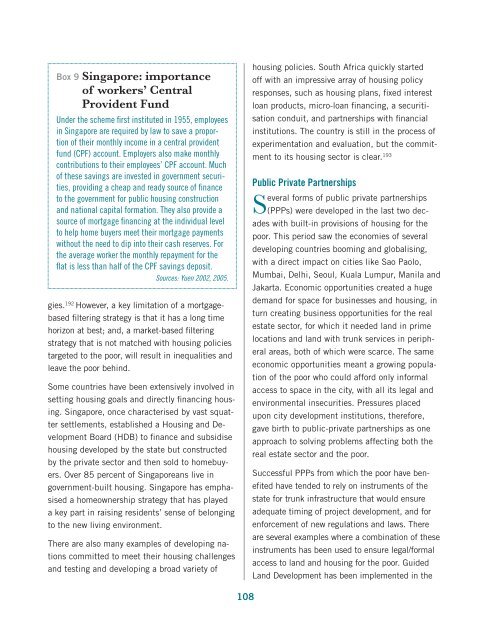Download the file - United Nations Rule of Law
Download the file - United Nations Rule of Law
Download the file - United Nations Rule of Law
Create successful ePaper yourself
Turn your PDF publications into a flip-book with our unique Google optimized e-Paper software.
Box 9 Singapore: importance<strong>of</strong> workers’ CentralProvident FundUnder <strong>the</strong> scheme first instituted in 1955, employeesin Singapore are required by law to save a proportion<strong>of</strong> <strong>the</strong>ir monthly income in a central providentfund (CPF) account. Employers also make monthlycontributions to <strong>the</strong>ir employees’ CPF account. Much<strong>of</strong> <strong>the</strong>se savings are invested in government securities,providing a cheap and ready source <strong>of</strong> financeto <strong>the</strong> government for public housing constructionand national capital formation. They also provide asource <strong>of</strong> mortgage financing at <strong>the</strong> individual levelto help home buyers meet <strong>the</strong>ir mortgage paymentswithout <strong>the</strong> need to dip into <strong>the</strong>ir cash reserves. For<strong>the</strong> average worker <strong>the</strong> monthly repayment for <strong>the</strong>fl at is less than half <strong>of</strong> <strong>the</strong> CPF savings deposit.Sources: Yuen 2002, 2005.gies. 192 However, a key limitation <strong>of</strong> a mortgagebasedfiltering strategy is that it has a long timehorizon at best; and, a market-based filteringstrategy that is not matched with housing policiestargeted to <strong>the</strong> poor, will result in inequalities andleave <strong>the</strong> poor behind.Some countries have been extensively involved insetting housing goals and directly financing housing.Singapore, once characterised by vast squattersettlements, established a Housing and DevelopmentBoard (HDB) to finance and subsidisehousing developed by <strong>the</strong> state but constructedby <strong>the</strong> private sector and <strong>the</strong>n sold to homebuyers.Over 85 percent <strong>of</strong> Singaporeans live ingovernment-built housing. Singapore has emphasiseda homeownership strategy that has playeda key part in raising residents’ sense <strong>of</strong> belongingto <strong>the</strong> new living environment.There are also many examples <strong>of</strong> developing nationscommitted to meet <strong>the</strong>ir housing challengesand testing and developing a broad variety <strong>of</strong>housing policies. South Africa quickly started<strong>of</strong>f with an impressive array <strong>of</strong> housing policyresponses, such as housing plans, fixed interestloan products, micro-loan financing, a securitisationconduit, and partnerships with financialinstitutions. The country is still in <strong>the</strong> process <strong>of</strong>experimentation and evaluation, but <strong>the</strong> commitmentto its housing sector is clear. 193Public Private PartnershipsSeveral forms <strong>of</strong> public private partnerships(PPPs) were developed in <strong>the</strong> last two decadeswith built-in provisions <strong>of</strong> housing for <strong>the</strong>poor. This period saw <strong>the</strong> economies <strong>of</strong> severaldeveloping countries booming and globalising,with a direct impact on cities like Sao Paolo,Mumbai, Delhi, Seoul, Kuala Lumpur, Manila andJakarta. Economic opportunities created a hugedemand for space for businesses and housing, inturn creating business opportunities for <strong>the</strong> realestate sector, for which it needed land in primelocations and land with trunk services in peripheralareas, both <strong>of</strong> which were scarce. The sameeconomic opportunities meant a growing population<strong>of</strong> <strong>the</strong> poor who could afford only informalaccess to space in <strong>the</strong> city, with all its legal andenvironmental insecurities. Pressures placedupon city development institutions, <strong>the</strong>refore,gave birth to public-private partnerships as oneapproach to solving problems affecting both <strong>the</strong>real estate sector and <strong>the</strong> poor.Successful PPPs from which <strong>the</strong> poor have benefitedhave tended to rely on instruments <strong>of</strong> <strong>the</strong>state for trunk infrastructure that would ensureadequate timing <strong>of</strong> project development, and forenforcement <strong>of</strong> new regulations and laws. Thereare several examples where a combination <strong>of</strong> <strong>the</strong>seinstruments has been used to ensure legal/formalaccess to land and housing for <strong>the</strong> poor. GuidedLand Development has been implemented in <strong>the</strong>108
















